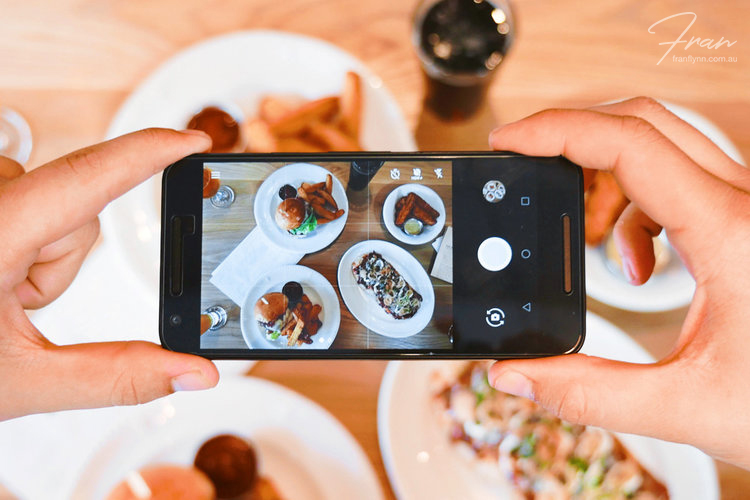Food Photography - Digital SLR versus iphone/smartphone
You'll often see advertisers triumphantly proclaim that the SLR is dead and the latest awe-inspiring smartphone or iphone will render DSLRs (digital single lens reflex cameras) obsolete, and their phone will become the holy grail for photography.
While it's an interesting notion, in my opinion, SLRs are here to stay for quite some time yet -maybe even until food photographers like me are replaced by robots! (which might not be as far away as we might think....)
Let's do a quick comparison so you can understand why.
PORTABILITY
iphone/smartphone
Light, compact and always available a phone is pretty idyllic when it comes to convenience. This for me is the biggest reason why you would would prioritise using a phone over a DSLR camera.
Digtal SLR
Comparatively heavy and cumbersome, an SLR isn't winning any awards for discretion and that's before you even consider what lenses are necessary to produce a cracking shot - so the bottom line is, bring a big bag.
WINNER FOR PORTABILITY phone camera
------------------------------------
DEPTH OF FIELD
Depth of field is a functionality within a camera lens which allows you to create a crisp 'in-focus' area, surrounded by an 'out-of-focus' area. It could arguably be the most coveted feature in photography, given that it can often make otherwise average images look amazing!
Depth of field is controlled by an adjustable function called aperture within a camera lens. It essentially relates to how a lens opens and closes its 'eye', using a series of overlapping 'leaves'. Large apertures (with small f/numbers) have the largest opening, and correspond with smallest area of focus. Conversely small apertures (with large f/numbers) have the largest area of focus.
iphone/smartphone
Smartphones have 'fixed' apertures. This means that the aperture is not adjustable by the user. Having said that, there are many apps available that offer you the ability to create the impression of adjustable depth of field by selectively blurring areas of your shot.
Digtal SLR
Depth of field is controlled by a functionality within a camera lens, therefore your choice of DSLR camera won't affect the result however your choice of lens is absolutely key. It is a more complex function for a lens to open the interconnecting 'leaves' of the 'eye' completely, particularly in a zoom lens - therefore this functionality is often compromised in less expensive, and zoom lenses.
More expensive lenses generally have a broader scope at the 'narrow/small' end of the depth of field scale (ie smaller area of focus and larger apertures). Most lenses have comparative ability at the 'wide/big' end of the depth of field scale (ie smaller apertures), although vinetting can sometimes be an issue. This is when the four corners of your images start to darken and lose quality. Having said that, some people like the look that vinetting (while actually a result of limitation) produces.
Bottom line: if you want beautiful narrow depth of field images, you need a lens that is capable of producing that, and you're likely to spend a few $s to get your ideal results - but it's so worth it. (note: there might be a smidgen of bias in this article!)
WINNER FOR DEPTH OF FIELD SLR
SHUTTER SPEED
Visualise your camera lens directing a tunnel of light from the outside world to your camera sensor. The 'shutter' is the door between your sensor and the light. The longer the door is open the more light that gets in, and in the process it 'burns' an image onto the sensor.
In a well-light scene the shutter only needs to be open for a fraction of a second to allow enough light in to create a well exposed image. When shooting indoors and in soft/poor lighting conditions, the shutter needs to be open for much longer for the image to be exposed long enough. The problem is that when the door is open for longer than a fraction of a second, our natural micro movements create a sense of movement in the image, which presents as an undesirable blurred or out of focus image.
iphone/smartphone
Some phone cameras have a special built-in feature called optical image stabilisation (OIS) which makes it possible to take a picture at shutter speeds that would normally require a tripod to avoid camera shake. It is possible to buy small table top tripods or tripod modifiers for full size light stands. It is also possible to download apps that allow you to select shutter speeds manually rather than being limited to the auto range.
Download a FREE chapter of my ebook 'The Ultimate Guide to Natural Light for Food Photography' by adding your details here:
Digtal SLR
All digital SLR cameras with a manual function allow you to select a shutter speed from a fraction of a section through to several minutes (or hours if wish on a BULB setting). Once you get below a certain shutter speed a tripod is an essential, particularly when you are using a heavy lens. Some lenses offer image stabilisation features which help you to hand-hold down to slightly slower shutter speeds.
WINNER FOR SHUTTER SPEED I'm calling this a tie because this one really depends on whether you are a beginner or more advanced. If you are a beginner your phone will do a good job, even in semi-low light without a tripod. An SLR will need a tripod more quickly, but it is also much more flexible in terms of how slow you can ultimately make your shutter speed. If you're more advanced the SLR is definitely the winner here, but phone cameras are often more flexible with shutter speeds than they are given credit for, but you do usually need to download an app to manage slow shutter speeds manually.
LENSES
iphone/smartphone
Phone cameras come with a fixed wide angle lens. This means that it is not interchangeable, and therefore you are restricted to the angle of view that it offers which is usually very broad (as opposed to close up). Most phone cameras offer a digital zoom effect. This is really more of an optical illusion as opposed to a genuine zoom - so as you zoom you'll notice the quality of the image decreases. It is possible to buy clip on zoom lens for mobile phones, but I'm yet to see one that is anything more than a gimmick.
Digtal SLR
The beauty of a digital SLR is that you can interchange lenses, so you have a huge breath of flexibility in terms of what angle of view you would like. A real estate or architectural photographer can use the same camera, but buy vastly different lenses to a food photographer, to suit their specific needs. A wildlife or sports photographer might use similar lenses and a portrait and wedding photographer are likely to have similar needs to each other also.
There is a broad diversity in terms of available zoom levels and depth of field function and the only limit seems to be your bank balance.
WINNER FOR LENSES Without a doubt the SLR wins here. A food photographer using a phone camera will get frustrated quite quickly with the restriction of a fixed phone lens, particularly for closeup images.
ISO
ISO controls the sensitivity of the sensor to light. At the low end of the scale, eg. ISO 100, the sensor is less sensitive to light and at the higher end of the scale eg. ISO 1600+ the sensor is much more sensitive (or reactionary) to light. This means that in a low-light situation, if your camera is set to a high ISO you have a better chance to imprint an image.
The downside to ISO is that at the high end of the scale there is usually a degradation in the image quality - e.g. the image looks less sharp, pixels become more evident and in very dark areas random coloured pixel (often green or red) will sometimes be evident. This degradation is known as 'noise'. For me, increasing ISO is a last resort option for getting more light into the camera when you're not in a position to use a tripod.
iphone/smartphone
You need to be in manual mode to be able to select the ISO rating. Smart phones generally don't go much higher than 1600 ISO, but in combination with optical image stabilisation (OIS) they can still create a good shot in low light.
SLR
Some high end SLR cameras can have ISO rating of as low as 50 ISO and as high as 25600 and beyond. This is substantially higher than a smart phone. On an SLR you also need to be in manual mode to be able to set your ISO yourself. Several high end SLRs are capable of producing very high quality images even at high ISO setting, and the degradation can be almost absent.
WINNER FOR ISO Definitely SLR
conclusion
While there is no doubt that iphones and other smart phone cameras have advanced in leaps and bounds, to the point that it is possible to buy a phone with a more than acceptable camera, there are also limitations. If you are serious about food photography you will inevitably need to learn manual mode at some stage, to be able to make full use of camera functionality.
While smart phones do offer some manual configuration with the assistance of apps, the limitations posed by fixed lenses and lack of genuine depth of field are too much to overlook. In food photography flexibility with apertures, shutter speeds, focal lengths and to a lesser extent ISO, are essential tools to be able to get the best quality pictures possible.
While some smart phones definitely have the capability to produce good shots, once you are in a difficult lighting environment, or you want an epic closeup, you are likely to start feeling quite limited.
While having a smart phone with a good camera built-in available at all times is pretty much essential these days, when it comes to professional work it's SLR all the way for me!
------------------------------------------------------------------------
Note: the non-food images, ie: numbers 1, 3, 4 & 5 are stock images downloaded from unsplash.com
You might also like:
Hi I'm Fran, a professional photographer and designer based on the Gold Coast in Australia. I’m a lifelong creative, passionate about producing drool-worthy images that provoke emotion and communicate deliciousness. My obsession is teaching others how to achieve the satisfaction of realising their creative vision too. I also love to produce high quality visual books (especially cook books) for my clients.










